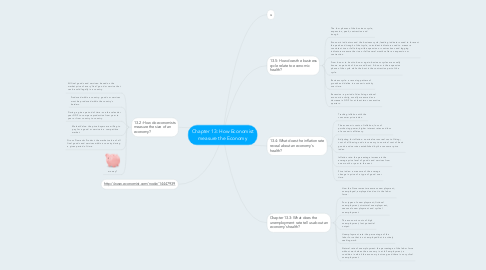Chapter 13: How Economist measure the Economy
by Kristen Garske

1. u
2. 13.2: How do economists measure the size of an economy?
2.1. All final goods and services: based on the market price of every 'final' good or service that can be sold legally in a country.
2.2. Produced within a country: goods or services must be produced within the country's borders.
2.3. During a given period of time: use the calendar year GDP to compare production from year to year or from country to country.
2.4. Market Value: the price buyers are willing to pay for a good or service in a competitive market.
2.5. Gross Domestic Product: the market value of all final goods and services within a country during a given period of time.
2.6. money?
3. 13.5: How does the business cycle relate to economic health?
3.1. The four phases of the business cycle; expansion, peak, contraction and trough.
3.2. Economic indicators and the business cycle; leading indicators used to forecast the peak and trough of that cycle, coincident indicators used to measure consistent rise or fall along with expansion or contractions and lagging indicators measure the rise or fall several months after an expansion or contraction.
3.3. From boom to bust to boom again: business cycles are usually known as periods of boom and bust. A boom is the expansion phase of the cycle while the bust is the contraction part of the cycle.
3.4. Business cycle: a recurring pattern of growth and deline in economic activity over time.
3.5. Recession: a period of declining national economic activity, usually measured as a decrease in GDP for at least two consecutive quarters.
4. 13.4: What does the inflation rate reveal about an economy's health?
4.1. Tracking inflation with the consumer price index.
4.2. The economic costs of inflation; loss of purchasing power, higher interest rates and loss of economic efficiency.
4.3. Adjusting for inflation: nominal versus real cost of living; cost of all basic goods in currency to nominal cost of basic goods and services established by the consumer price index.
4.4. Inflation rate: the percentage increase in the average price level of goods and services from one month or year to the next.
4.5. Price index: a measure of the average change in price of a type of good over time.
5. Chapter 13.3: What does the unemployment rate tell us about an economy's health?
5.1. How the Government measures unemployment; unemployed, employed and not in the labor force.
5.2. Four types of unemployment; fictional unemployment, structural unemployment, seasonal unemployment and cyclical unemployment.
5.3. The economic costs of high unemployment; lost potential output.
5.4. Unemployment rate: the percentage of the labor force that is not employed but is actively seeking work.
5.5. Natural rate of unemployment: the percentage of the labor force without work when the economy is at full employment; a condition in which the economy is strong and there is no cyclical unemployment.
6. http://www.economist.com/node/14447939


